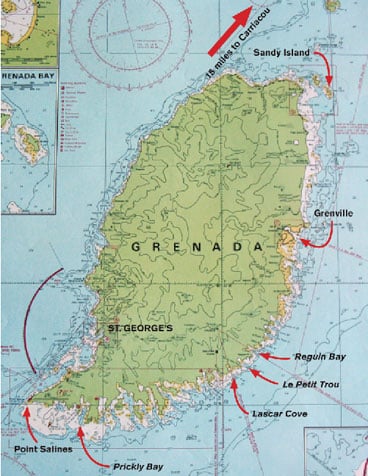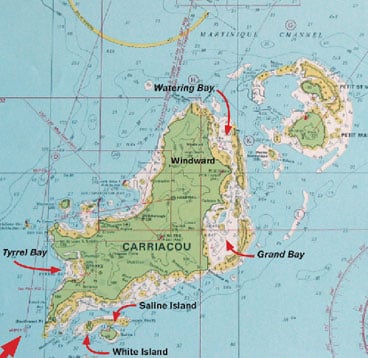
reproduced courtesy of imray, laurie, norie, and wilson ltd. (www.imray.com)| |You might voyage up the west coast of Grenada, but you’ll burn lots of diesel, the only harbor north of St. George’s is home to a garbage dump, and your reward will be an open-water bash across to Carriacou. However, if you take short hops up the island’s east coast, you can explore some rarely visited coves and the harbor at Grenville, where the flavor of the old days in the Caribbean can still be savored. A good reach ends the leg to Carriacou.| Sailors heading north to Carriacou from the south coast of Grenada have two choices. Most go via the west coast, thinking that they’ll be in the lee of the island, but as often as not, it’s an all-day slog, and the crew arrives in Carriacou dead beat. If that’s the hard way, an alternate is to take what I call the easy way: Sail up the east coast in stages and visit numerous secluded anchorages, then go on to the south and east coasts of Carriacou, two of the nicest and least-visited cruising areas in the eastern Caribbean.
If you start in Prickly Bay and go up the west coast of Grenada, it’s a few miles downwind from your anchorage on the south coast to Point Salines, where you harden up and then can expect 15 miles of hard-on-the-wind sailing or motorsailing up the coast. From Tanga Langua, the northwest tip of Grenada, it’s 15 miles to Tyrrel Bay, Carriacou. That’s 15 miles as the crow flies, but you probably won’t lay the course, so it usually ends up being closer to 20 to 25 miles of hard slogging to windward. If you want to arrive in Carriacou before sunset, you’ll have to get an early departure and be prepared for a very long day.
The route up the east coast of Grenada is an interesting option and one that’s certainly off the beaten track, as few cruisers visit the area, and there are almost no charter boats. I advise breaking the trip into several short hops.
The south and east coasts of Grenada are peppered with coves, each one with its own charms. If you leave Prickly Bay very early in the morning before the wind builds, you’ll be anchored for brunch. You’ll sail hard on the breeze, short tacking along the shore to avoid adverse current and seas. After 10 miles of sailing, you’ll have a choice of three coves: Lascar Cove, which has a small, first-rate anchorage in its northeast corner; Le Petit Trou, with a nice beach and excellent shelter, except when the wind is well into the south; or Requin Bay, with its deserted beach and sometimes rolly anchorage. The chart doesn’t show enough detail, so don’t try these coves without consulting Street’s Cruising Guide to the Eastern Caribbean-Martinique to Trinidad, published by iUniverse.com.
The next morning, again leave early. After short port tacks and long starboard tacks, you’ll have a choice of two equally enticing anchorages. Grenville, about 6 miles from your jump-off point, is the second largest town on the island and isn’t often visited by yachts; it has a real old-time Caribbean flavor.
Or you may decide to continue on to near the northeast corner of Grenada and anchor at Sandy Island, which has some excellent shell collecting on the beaches, snorkeling along the reef, and an anchorage swept by strong currents.
From Sandy Island, you should be able to sail the 15 miles to Carriacou on one tack, even if the wind is a little north of east. If the wind is east, it’s a close reach; if it’s south of east, you’ll have a glorious romp. If this run is done with a weather-going tide (see the back of Imray-Iolaire chart B-32), it’s guaranteed to be a reach rather than a beat.
Instead of heading to Tyrrel Bay, head for White Island or Saline Island and sail north in smooth water behind the barrier reef in Grand Bay. Anchor behind the reef or continue-if you draw 7 feet or less-on to Watering Bay and Windward, where they still build traditional Carriacou sloops and schooners.

reproduced courtesy of imray, laurie, norie, and wilson ltd. (www.imray.com)| |When you get to Carriacou, don’t head for Tyrrel Bay, the usual stop for cruisers. Instead, if your draft allows, sail inside the reef on the weather side of the island to enjoy the diving and anchorages there. You’ll have to rely on eyeball navigation, but it’s worth the trip.|
From Kendance Point north to Windward lies four miles of glorious sailing inside the barrier reef with nothing to windward of you except Africa. Eyeball navigation is necessary, but 9 feet can be carried inside the reef north to Windward, though from Point St. Hilaire any boat drawing more than 7 feet should proceed under power at dead slow or send the dinghy ahead to sound the passage because hurricanes have passed through this area since I last sounded it in the early years of this century on Li’l Iolaire, my 28-foot J. Francis Jones yawl.
It’s been 30 years since I sailed north up the west coast of Grenada-the hard way-to Carriacou. Since the mid 1970s, I’ve always sailed up the east coast in stages. The “experts” tell me that I’m nuts. One kind of expert has usually spent his previous career in the Mediterranean or in the Pacific and has been in the Caribbean for only a few years. His time in the Caribbean has mostly been behind a desk running a bareboat operation-a very tough job, but he’s not out cruising. The other sort of expert is a cruising yachtsman who’s been in the Caribbean for four or five years and now knows everything about these islands.
It’s possible that in the 50 years that I’ve spent in the Caribbean, I’ve learned a few things. The Caribbean hasn’t been ruined. You can get off the beaten track.
Don Street is available as a rock, tide, and wind pilot for those who’d like a guide while exploring off the beaten track in the Caribbean. For more information, visit his website (www.street-iolaire.com). Street will give presentations at the 2008 Newport Boat Show in Rhode Island and at the 2008 U.S. Sailboat Show in Annapolis.







